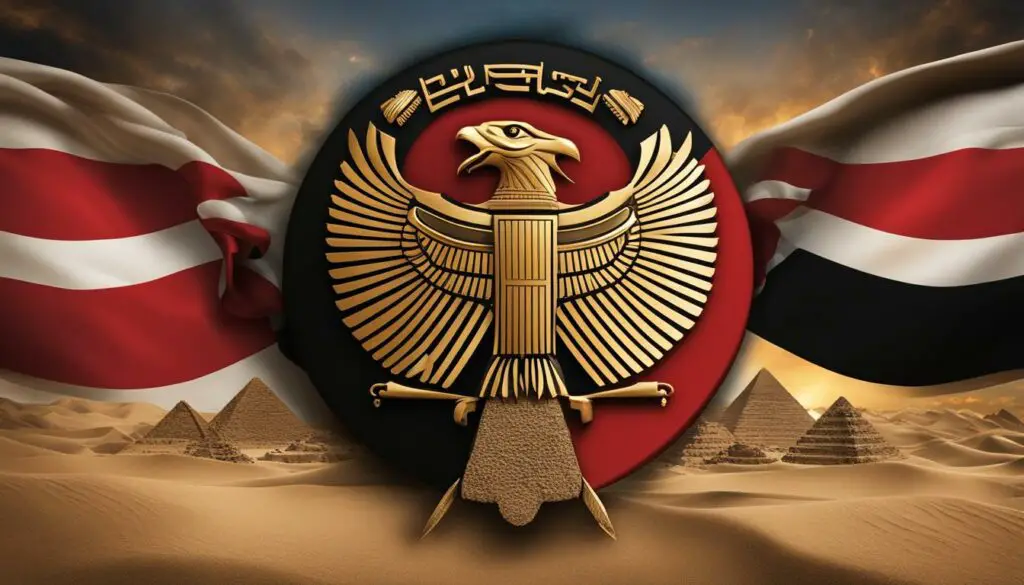The Egyptian flag holds great significance and has evolved throughout the country’s history. It represents the identity, pride, and belief of the Egyptian citizens. The flag has undergone several changes in both its design and symbolism over the years.
Evolution of the Egyptian Flag
The Egyptian flag has a rich history and has gone through significant changes over the years, reflecting the country’s evolving political landscape and aspirations for independence. Understanding the symbolism behind the colors and symbols on the flag provides insights into Egypt’s heritage and values.
The first Egyptian flag was introduced in 1805 by Mohamed Ali, a prominent leader in Egyptian history. It featured a red banner with three white crescents and stars. These symbols represented Mohamed Ali’s victories in Africa, Asia, and Europe, as well as his sovereignty over Egypt, Sudan, and Hejaz. The flag was a representation of Ali’s power and accomplishments.
As Egypt’s struggle for independence progressed, so did the design of the flag. Different variations were introduced to symbolize the changing political landscape and aspirations of the Egyptian people. Finally, in 1984, the current flag was adopted, featuring three horizontal stripes of red, white, and black. Each color carries its own significance.
- The red stripe symbolizes the sacrifices and bloodshed of Egyptian martyrs who fought for their nation’s freedom.
- The white stripe represents peace, unity, and tolerance among the diverse population of Egypt.
- The black stripe represents the dark period of occupation and oppression, highlighting Egypt’s journey towards liberation and independence.
In addition to the colors, the Egyptian flag features an emblem of an eagle in the center of the white stripe. This emblem represents strength and power, reflecting the resilience of the Egyptian people and their commitment to protecting their nation’s sovereignty.
Evolution of the Egyptian Flag
| Year | Flag Description |
|---|---|
| 1805 | Red flag with three white crescents and stars representing the victories of Mohamed Ali and his sovereignty over Egypt, Sudan, and Hejaz. |
| 1922 | Flag with a green background, a big white crescent, and three white stars symbolizing the unity between Egypt, Nubia, and Sudan after gaining independence from British control. |
| 1952 | Red, white, and black horizontal stripes representing the struggle against British occupation, the peaceful transition to a republic, and the end of oppression. |
| 1958 | Flag with two green stars symbolizing the union between Egypt and Syria during the United Arab Republic (UAR) era. |
| 1972 | Flag featuring the Hawk of Qureish, representing Arab nationalism, during the Federation of Arab Republics period. |
| 1984-Present | Current flag with red, white, and black horizontal stripes symbolizing sacrifice, peace, and the dark period of occupation, with the emblem of an eagle representing strength and power. |
The evolution of the Egyptian flag reflects the country’s journey towards freedom, independence, and national pride. Each change in the flag’s design and symbolism carries historical significance and represents the values cherished by the Egyptian people.
Historical Significance of Flag Changes
Each change in the Egyptian flag throughout history has held deep historical significance. In 1922, Egypt gained independence from British control, and King Fuad I introduced a new flag to symbolize unity between Egypt, Nubia, and Sudan. The flag featured three white stars inside a big white crescent on a green background.
In 1952, the revolution brought about another flag change. The new flag consisted of red, white, and black horizontal stripes, representing the struggle against British occupation, the peaceful transition to a republic, and the end of oppression.
Subsequent flag changes were influenced by political unions and alliances. During the United Arab Republic (UAR) era, the flag featured two green stars, symbolizing the union between Egypt and Syria. Then, the Federation of Arab Republics introduced a flag with the Hawk of Qureish, representing Arab nationalism.
Finally, in 1984, the current flag was adopted. It features the Eagle of Saladin, a powerful symbol of Egypt’s historical strength and sovereignty.

| Year | Flag Design | Symbolism |
|---|---|---|
| 1922 | Green flag with three white stars inside a white crescent | Unity between Egypt, Nubia, and Sudan |
| 1952 | Red, white, and black horizontal stripes | Struggle against British occupation, peaceful transition to a republic, end of oppression |
| United Arab Republic (UAR) Era | Two green stars | Union between Egypt and Syria |
| Federation of Arab Republics | Hawk of Qureish | Arab nationalism |
| 1984 – Present | Eagle of Saladin | Symbol of Egypt’s historical strength and sovereignty |
The Egyptian National Anthem
The Egyptian national anthem, “Bilady,” holds equal importance alongside the flag. Composed by Mohamed Younis al Qaday and Sayed Darwish, the lyrics were taken from a speech by Egyptian lawyer Mustafa Kamel in 1907. The anthem symbolizes the patriotic spirit and unity of the Egyptian people. Over the years, different versions of the anthem have been used, representing the changing political and social landscape of Egypt.

The Pride and Identity of the Egyptian People
The Egyptian flag and national anthem hold deep significance for the Egyptian people, serving as powerful symbols of pride and national identity. Each morning, students from across the nation stand in respect of the flag, singing the national anthem with unwavering devotion. This ritual not only embodies their love for the country but also reinforces the profound meaning behind Egypt’s flag.
The flag’s symbolism is multi-layered, carrying the weight of Egypt’s history and aspirations. Its colors and emblem represent the core values of the nation. The red color symbolizes the sacrifices and bloodshed of Egyptian martyrs, while the white color represents peace, a cherished ideal for the Egyptian people. The black stripe signifies the dark era of foreign occupation, and the powerful presence of the Eagle of Saladin on the flag embodies strength and sovereignty.
Through its symbolism, the Egyptian flag captures the spirit of the nation and its people. It reflects the profound aspirations for peace, strength, and independence that have shaped Egypt’s history. The flag and national anthem serve as a beacon of unity, reminding Egyptians of their shared heritage and inspiring them to strive for progress and unity. By honoring the flag and singing the national anthem, the Egyptian people reinforce their deep-rooted pride and strengthen their connection to their country and its rich history.
FAQ
What does the Egyptian flag represent?
The Egyptian flag represents the identity, pride, and belief of the Egyptian citizens. It symbolizes the sacrifices of the Egyptian martyrs, the aspiration for peace, and the historical strength and sovereignty of Egypt.
How has the Egyptian flag evolved over time?
The Egyptian flag has undergone several changes in both its design and symbolism. It started with a red banner featuring three white crescents and stars, representing Mohamed Ali’s victories. It later transitioned to a flag with red, white, and black horizontal stripes, symbolizing the struggle against British occupation and the end of oppression. The current flag, adopted in 1984, features red, white, and black horizontal stripes with the Eagle of Saladin emblem.
What is the historical significance of flag changes in Egypt?
Each change in the Egyptian flag holds deep historical significance. From symbolizing the unity between Egypt, Nubia, and Sudan to representing political unions and alliances, the flag changes reflect Egypt’s evolving political landscape and aspirations for independence.
What is the Egyptian national anthem?
The Egyptian national anthem is called “Bilady.” It is a patriotic song that symbolizes the unity and patriotic spirit of the Egyptian people. Its lyrics were taken from a speech by Egyptian lawyer Mustafa Kamel in 1907.
What is the significance of the Egyptian flag and national anthem to the Egyptian people?
The Egyptian flag and national anthem instill a sense of pride and identity in the Egyptian people. Students across the nation stand in respect of the flag every morning, singing the national anthem. These symbols represent the aspirations, values, and rich history of Egypt as the country continues its journey towards progress and unity.
